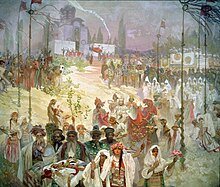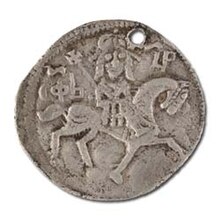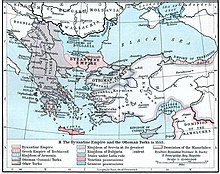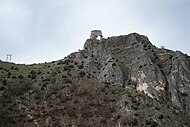Stefan Dušan
| Stefan Dušan Стефан Душан | |
|---|---|
Serbian Orthodox Christian |
Dušan conquered a large part of southeast Europe, becoming one of the most powerful monarchs of the era. Under Dušan's rule, Serbia was the most powerful state in
After Dušan's sudden death in 1355, the empire began to weaken. With the death of Dušan's successor, emperor Stefan Uroš V, the Serbian Empire was definitively divided into a large number of independent Serbian states, among which the Serbian Despotate will stand out as the most prominent under the rule of Lazarević dynasty.
Background
In 1314, Serbian King
Milutin became ill and died on 29 October 1321, and Konstantin was crowned king.[10] Civil war erupted immediately, as Dečanski and his cousin, Stefan Vladislav II, claimed the throne. Konstantin refused to submit to Dečanski, who then invaded Zeta, defeating and killing Konstantin.[10] Dečanski was crowned king on 6 January 1322 by Nicodemus, and his son, Stefan Dušan, was crowned "young king".[9] Dečanski later granted Zeta to Dušan, indicating him as the intended heir.[10] Since April 1326 Dušan appears in written sources as the "young king" and ruler in Zeta and Zahumlje.[11] From that fact and the "Old Serbian genealogies and annals", in recent works, some Serbian historians write that Dusan was 14 years old probably in March, or April 1326, and that he was born in 1312, not around 1308.[12][13]
In the meantime, Vladislav II mobilized local support from Rudnik, the former appanage of his father, Stefan Dragutin.[10] Vladislav proclaimed himself king, and he was supported by the Hungarians, consolidating control over his lands and preparing for battle with Dečanski.[10] As was the case with their fathers, Serbia was divided by the two independent rulers; in 1322 and 1323 Ragusan merchants freely visited both lands.[10]
In 1323, war broke out between Dečanski and Vladislav. Rudnik had fallen to Dečanski by the end of 1323, and Vladislav appeared to have fled north.[10] Vladislav was defeated in battle in late 1324 and fled to Hungary,[14] leaving the Serbian throne to Dečanski as undisputed "king of All Serbian and Maritime lands".
Biography
Youth and usurpation
Dušan was the eldest son of King

Dečanski's decision not to attack the Byzantines after the victory at Velbazhd, when he had an opportunity, resulted in the alienation of many nobles,
Personal traits
Contemporary writers described Dušan as unusually tall and strong, "the tallest man of his time", very handsome, and a rare leader full of dynamism, quick intelligence, and strength,[17][18] bearing "a kingly presence".[19] According to contemporary depictions, he had dark hair and brown eyes; in adult age he grew a beard and longer hair.
Early reign
Serbia made some raids into the Macedonia region in late 1331, but a planned major attack on Byzantium was delayed as Dušan had to suppress revolts in Zeta in 1332.[20] Dušan's ingratitude toward those who had aided his rise – the Zetan nobility may have been neglected their promised reward and greater influence – may have been the cause of the rebellion, which was suppressed in the course of the same year.[20]

The struggle between Dušan and Stefan Dečanski prevented Serbian intervention in Bulgaria on behalf of Anna and Ivan Stephen and they were overthrown by Ivan Alexander in March 1331, however Ivan Alexander of Bulgaria was aware of future danger from Serbia and immediately sought peace with Dušan. Two rulers concluded peace and formed an alliance, sealed with Dušan's marriage to Ivan Alexander's sister Helen of Bulgaria. Good relations with Bulgaria continued during Dušan's reign and trough Bulgaria was weaker then Serbia, it did not suffer any legal dependence.[16]
In 1333 after negotiations with Ragusa, Dušan sold Ston and its envisions, including the Pelješac peninsula and the coastland between Ston and Dubrovnik for eight thousand perpers and an annual tribute of five hundred perpers. Ragusa also had to guarantee freedom of worship for Orthodox believers in this territory.[21]
Dušan began campaigning against the Byzantine Empire in 1333. In late 1333, a leading Byzantine general Syrgiannes revolted against Andronikos III and sought Dušan's help.[21] In spring of 1334 Serbs launched an attack on Byzantine Macedonia, benefiting greatly due to Syrgiannes' strategic abilities, knowledge of Byzantine position and his allies that surrendered fortresses to Serbs.[21] Peace with Byzantines was concluded on 26. August 1334, with Byzantines recognizing Serbian gains in Ohrid, Prilep, Strumitsa, Siderokastron, Chermen and Prosek.[22] Hungarians, knowing of Dušan's involvement in the south, were mobilizing to attack Serbia from the north. Hungarians, not expecting any serious Serbian resistance penetrated deep into Serbia, reaching neighborhood of Žiča monastery. Hungarians have received military support from Stephen II of Bosnia. Dušan marched north to face Hungarians. Hungarians quickly withdrew their armies to avoid Dušan's army.[23] Charles I was wounded by an arrow but survived. As a result, the Hungarians lost Mačva and Belgrade in 1335. Dušan then focused his attention on the internal affairs of his country, writing, in 1349, the first statute book of the Serbs.[24]
Dušan exploited the civil war in the Byzantine Empire between the regent of the minor Emperor John V Palaiologos, Anna of Savoy, and his father's general John Kantakouzenos. Dušan and Ivan Alexander picked opposite sides in the conflict but remained at peace with each other, taking advantage of the Byzantine civil war to secure gains for themselves.
Dušan's systematic offensive began in 1342, and in the end he conquered all Byzantine territories in the western
In 1343, Dušan added "of Romans (Greeks)" to his self-styled title "King of Serbia, Albania and the coast".
Imperial coronation and autocephaly of the Serbian church


On 16 April 1346 (Easter), Dušan convoked a huge assembly at

The Serbian Patriarchate took over sovereignty on Mt. Athos and the Greek eparchies under the jurisdiction of the Ecumenical Patriarchate of Constantinople, while the Archbishopric of Ohrid remained autocephalous. For those acts he was excommunicated by the Ecumenical Patriarch of Constantinople in 1350.[34]
Epirus and Thessaly
In 1347, Dušan conquered Epirus, Aetolia and Acarnania, appointing his half-brother, despot Simeon Uroš as governor of those provinces. In 1348, Dušan also conquered Thessaly, appointing Preljub as governor. In eastern regions of Macedonia, he appointed Vojihna as governor of Drama. Once Dušan conquered Byzantine possessions in western regions, he sought to obtain Constantinople.[35] To acquire the city, he needed a fleet.[35] Knowing that fleets of southern Serbian Dalmatian towns were not strong enough to overcome Constantinople, he opened negotiations with Venice, with which he maintained fairly good relations.[35] Venice feared a reduction of privileges in the Empire if Serbs became the masters of Constantinople over the weakened Byzantines. But if the Venetians had allied with Serbia, Dušan would have examined existing privileges. Once he became master of all Byzantine lands (especially Thessalonika and Constantinople) the Venetians would have gained privileges. But Venice chose to avoid a military alliance.[35] While Dušan sought Venetian aid against Byzantium, the Venetians sought Serbian support in the struggle against the Hungarians over Dalmatia. When sensing that Serbian aid would result in a Venetian obligation to Serbia, Venice politely turned down Dušan's offers of help.[35]

While Dušan launched the Bosnian campaign (absent the Serbian troops in Macedonia and Thessaly), Kantakouzenos tried to regain lands Byzantium had lost.[36] In his support, the Constantinopolitan patriarch Kallistos excommunicated Dušan to discourage the Greek population in Dušan's Greek provinces from supporting the Serbian administration and thereby assist the Kantakouzenos campaign.[36] The excommunication did not stop Dušan's relations with Mount Athos, which still addressed him as Emperor, though rather as Emperor of Serbs than Emperor of Serbs and Greeks.[37]
Kantakouzenos raised a small army and took the
War with the Bosnian principality

Dušan evidently wanted to expand his rule over the provinces that had earlier been in the hands of Serbia, such as

In 1350, Dušan attacked Bosnia, seeking to regain the previously lost land of Hum and stop raids on his tributaries at Konavle.
Dušan may have also launched the campaign to aid his sister, Jelena, who married
Last years and Death

In 1354 Dušan was attacked by Hungarians.
His empire slowly crumbled. His son and successor Stefan Uroš V could not keep the integrity of the Empire intact for long, as several feudal families immensely increased their power, though nominally acknowledging Uroš V as Emperor. Simeon Uroš, Dušan's half-brother, had proclaimed himself Emperor after the death of Dušan, ruling a large area of Thessaly and Epirus, which he had received from Dušan earlier.
Today Dušan's remains are in the Church of Saint Mark in Belgrade.[40] Dušan is the only monarch of the Nemanjić dynasty who has not been canonised as a saint.
Religious activity

Much like his ancestors, Emperor Dušan was very active in renovating churches and monasteries, and also for founding new ones. First, he cared for the monasteries in which his parents were buried. Both the
His greatest endowment was the
His son, Stefan Uroš V, did not make peace with the Constantinopolitan Patriarch. The first initiative was made by despot
Church policy
Dušan rejected Constantinople's claims to authority over the Serbian Orthodox Church and contemplated a religious union with the Latin Church.[41] In 1354, Dušan reached out to the Papal States, offering to recognise Pope Innocent VI as the "father of all Christians" and to solidify a union between the Catholic and Serbian Orthodox Church, in exchange for supporting Dušan in his plans for a military crusade against the Turks. Dušan's plans were welcomed, however such plans never materialized due to his death in 1355.[42][43]
With the raising of the Serbian Archbishopric to a Patriarchate, serious changes in the organization of the church followed. Joanikije II became Patriarch. Bishoprics (Eparchies) were raised to Metropolitanates, and new territories of the Ochrid Archbishopric and Ecumenical Constantinople were added to the jurisdiction of the Serbian church. The Ecumenical Patriarchate of Constantinople had Dušan excommunicated in 1350, although this did not affect the religious organization.
Under Serbian jurisdiction came one of the foremost centers of spirituality –
In his codex, Dušan accentuates his role as a protector of Christianity and points out the independence of the church. From the codex we can also see care that the parishes are equally arranged both in cities and villages. He was also taking care of few churches and monasteries from Bari to the west, to Jerusalem to the east.
Besides Orthodox Christians, there were many Catholics in the Empire, mostly in the coastal cities, Cattaro, Alessio (modern Lezhë) etc. In the court of Dušan there were also Catholics (servants from Cattaro and Ragusa, mercenaries, guests etc.). In the central parts, Saxons were in areas active in mining and trading. Serbia under Dušan claimed its identity through Orthodoxy, and opposition to Catholicism.[45] Catholics were persecuted, especially Catholic Albanians.[45][46][47]
Reign
Royal ideology

Some historians consider that the goal of Emperor Dušan was to establish a new, Serbian-Greek Empire, replacing the Byzantine Empire.[34] Ćirković considered his initial ideology as that of the previous Bulgarian emperors, who had envisioned co-rulership. However, starting in 1347, relations with John VI Kantakouzenos worsened, Dušan allied himself with rival John V Palaiologos.
Dušan was the first Serbian monarch who wrote most of his letters in Greek, also signing with the Imperial red ink. He was the first to publish prostagma, a kind of Byzantine document, characteristic for Byzantine rulers. In his royal title, Emperor of the Serbs and Greeks, his claim as Eastern Roman (Byzantine) successor is clear. He also gave Byzantine court titles to his nobility,[1] something that would continue into the 16th century.
Lawmaker


The most lasting monument to Dušan's rulership was a law code. For the purposes of Dušan's Code, a wealth of charters were published, and some great foreign works of law were translated to Serbian; however, the third section of the Code was new and distinctively Serbian, albeit with Byzantine influence and attention to a long legal tradition in Serbia. Dušan explained the purpose of his Code in one of in his charters; he intimated that its aims were spiritual and that the code would help his people to save themselves for the afterlife. The Code was proclaimed on 21 May 1349. in Skopje, and contained 155 clauses, while 66 further clauses were added at Serres in 1353 or 1354. The authors of the code are not known, but they were probably members of the court who specialised in law.
Dušan's Code proclaims on subjects both secular and ecclesiastic, the more so because Serbia had recently achieved full ecclesiastic autonomy as an independent Orthodox Church under a Patriarchate.[48] The first 38 clauses relate to the church and they deal with issues that the Medieval Serbian Church faced, while the next 25 clauses relate to the nobility. Civil law is largely excluded, since it was covered in earlier documents, namely Saint Sava's Nomokamon and in Corpus Juris Civilis. Dušan's Code originally dealt with criminal law, with heavy emphasis on the concept of lawfulness, which was mostly taken directly from Byzantine law.
The original manuscript of Dušan's Code does not survive. The Code continued as a de facto constitution under the rule of Dušan's son, Stefan Uroš V, and after the fall of the Serbian Empire in 1371, it was used in all the successor provinces. It was officially used in the successor state, Serbian Despotate,[49] until its annexation by the Ottoman Empire in 1459. The Code was used as a reference for Serbian communities under Turkish rule, which exercised considerable legal autonomy in civil cases.[49] The Code was also used in the Serbian autonomical areas under the Republic of Venice, like Grbalj and Paštrovići.[50]
Military tactics


Serbian tactics favored wedge shaped heavy cavalry attacks with horse archers on the flanks. Many foreign mercenaries were in the Serbian army in the 14th century, mostly German knights and
The Serbian expansion in the former territory of Byzantine Empire proceeded without a single major battle, it was based on besieging Greek fortifications.[52]
Name, epithets and titles

He was crowned Young King as
His epithet Silni (Силни) is translated into the Mighty,[56] but also the Great,[57] the Powerful[58] or the Strong.[59]
Legacy
Stefan Dušan was the most powerful Serbian ruler in the Middle Ages and remains a folk hero to Serbs. Dušan, a contemporary of England's Edward III, is regarded with the same reverence as the Bulgarians feel for Tsar Simeon I, the Poles for Sigismund I the Old, and the Czechs for Charles IV. According to Steven Runciman, he was "perhaps the most powerful ruler in Europe" during the 14th century.[60] His state was a rival to the regional powers of Byzantium and Hungary, and it encompassed a large territory, which would also be his empire's greatest weakness. By nature a soldier and a conqueror, Dušan also proved to be very able but nonetheless feared ruler. His empire however, slowly crumbled at the hands of his son, as regional aristocrats distanced from the central rule.
The aim of restoring Serbia as an Empire it once was, was one of the greatest ideals of Serbs, living both in the Ottoman and Austro-Hungarian lands. In 1526, Jovan Nenad, in the style of Dušan, proclaimed himself Emperor, when ruling a short-lived state of Serbian provinces under the crown of Hungary.
The Realm of the Slavs, written by Ragusian historian
After the restoration of Serbia in the 19th century, continuity with the Serbian Middle Ages was accentuated, particularly of its greatest moment – during Emperor Dušan. A political agenda, as with a restoration of his Empire, would find its place in the political programmes of the
Family

By his wife, Helena of Bulgaria, Emperor Dušan had at least one child, Stefan Uroš V, who succeeded his father as Emperor, r. 1355–1371. Dušan also had a daughter, Theodora, who married the Ottoman Sultan Orhan.[61]
But according to Nicephorus Gregoras, Dušan was negotiating a potential alliance with Orhan, which would have involved marrying off his daughter to Orhan himself or one of Orhan's sons in 1351. However, these negotiations broke down after the Serbian emissaries were attacked by Nikephoros Orsini – the marriage proposal was withdrawn and Serbia and the Ottoman Empire resumed hostilities.[62] Theodora most likely died between 1352 and 1354.
Some historians speculate that the couple had another child, a daughter.
Foundations
This section needs expansion. You can help by adding to it. (November 2011) |
- Saint Archangels Monastery
- Podlastva monastery
- Duljevo monastery
- A monumental church (27x14m) found near Aranđelovac in 2020[64]
Reconstructions:
In fiction
- Epic folk song "Ženidba Cara Dušana" ("Emperor Dušan's wedding").
- 1875 historical three-tome novel "Car Dušan" ("Emperor Dušan") by Dr Vladan Đorđević.[65]
- 1987 historical novel "Stefan Dušan" by Slavomir Nastasijević.[66]
- 2002 historical novel "Dušan Silni" ("Dušan the Great") by Mile Kordić.[67]
See also
- Serbian Empire
- Serbian Patriarchate of Peć
- Serbian Despotate
- Serbia in the Middle Ages
- Byzantine civil war of 1341–47
- Lesnovo monastery
- Danilo's anonymous pupil
Notes
- ^ a b c d e f g h i Fine 1994, p. 309.
- ^ White 2000, p. 246
- ^ Clissold 1968, p. 98
- ^ Hupchick 1995, p. 141
- ^ Positive Peace in Kosovo: A Dream Unfulfilled by Elisabeth Schleicher, p. 49, 2012
- ^ Bury, John Bagnell (1911). . In Chisholm, Hugh (ed.). Encyclopædia Britannica. Vol. 23 (11th ed.). Cambridge University Press. p. 517.
- ^ Fine 1994, pp. 260, 263
- ^ a b c Fine 1994, p. 262.
- ^ a b Fine 1994, p. 263.
- ^ a b c d e f g Fine 1994, p. 264.
- ^ a b Ječmenica 2012, pp. 35, 37, 39, 41–42.
- ^ a b Ječmenica 2012, pp. 34–35.
- ^ a b Logos 2017, p. 296.
- ^ Fine 1994, p. 265.
- ^ a b c d Fine 1994, p. 273.
- ^ a b c d Fine 1994, p. 274.
- ^ Paul Pavlovich, The Serbians: the story of a people, p. 35
- ^ William Miller, The Balkans: Roumania, Bulgaria, Servia, and Montenegro, p. 273: "Character of Dušan"
- ^ Andrew Archibald Paton, Researches on the Danube and the Adriatic, Vol 1, p. 17
- ^ a b Fine 1994, p. 275.
- ^ a b c Fine 1994, p. 287.
- ^ Fine 1994, p. 288.
- ^ Fine 1994, pp. 288–289.
- ^ Károly Szilágyi. "Hungarians and Serbs during the centuries". Archived from the original on 30 October 2010. Retrieved 8 October 2010.
- ^ Nicol (1993), p. 121: "The resulting assimilation of Byzantine culture by the Serbians helped to fortify the ideal of a Slavo-Byzantine Empire, which came to dominate the mind of Milutin's grandson, Stephen Dusan, later in the fourteenth century".
- ^ Radoman Stankovic, The Code of Serbian Emperor Stephan Dushan, Serbian Culture of the 14th Century. Volume I: "Powerful Byzantium started to decline, and young Serbian King Stephan Dushan, Stephan of Dechani's son, wanted, by getting crowned in 1331, to replace weakened Byzantium with the powerful Serbian-Greek Empire. [...] By proclaiming himself emperor of the Serbs and Greeks, Dushan showed that he aspired to a legitimate rule over the subjects of the Byzantine Empire".
- ^ Fine 1994, p. 303
- ^ Fine 1994, p. 304
- ^ Soulis 1984, p. 25
- ^ Vizantološki institut, Zbornik radova Vizantološkog instituta, (Naučno delo, 1996), 194.
- ISBN 978-0988712928.
In 1343, King Stephen Dušan issued a charter to the fortified city of Krujë. The original charter was written in Greek. It has been preserved in Latin translation in an attestation of the King of Aragon Alphonse V (1457). Dušan here calls himself "crales Bugarorum" [King of the Bulgarians].
- ^ George W. White. Nationalism and territory: constructing group identity in Southeastern Europe. Rowman & Littlefield. p. 193.
- ^ Ostrogorsky 1956, p. 468.
- ^ a b c d e Fine 1994, p. 310.
- ^ a b c d e f g h i Fine, p. 322
- ^ a b c d e f g h i j k l m Fine, p. 323
- ^ a b c d e f g h Fine 1994, p. 324
- ^ Dijana Pinjuh, Vjerske Prilike Kod Katolika u Hercegovini (Od Turskog Osvajanja Do Konca 17. Stoljeća, Zagreb, 2013. p. 15
- ^ a b c d e Fine 1994, p. 334.
- ISBN 1-84162-326-1
- ^ Ryder 2010, p. 244.
- ^ Dvornik 1962, p. 113.
- ^ Nicol 1993, p. 254.
- ^ p. 66
- ^ a b Alexandru Madgearu; Martin Gordon (2008). The Wars of the Balkan Peninsula: Their Medieval Origins. Scarecrow Press. p. 86.
- ^ Ines Angeli Murzaku (2015). Monasticism in Eastern Europe and the Former Soviet Republics. Routledge. p. 249.
- ^ Joan Mervyn Hussey (1966). The Cambridge Medieval History: The Byzantine Empire V. 2. Cambridge University Press. p. 540.
- ^ http://againandagaininpeace.com/2012/02/07/the-serbian-church-in-history-the-serbian-patriarchate/[permanent dead link]
- ^ a b Sedlar, p. 330
- ^ Sindik, I. (1951) Dušanovo zakonodavstvo u Paštrovićima i Grblju. u: Zbornik u čast šeste stogodišnjice Zakonika cara Dušana, Beograd: Srpska akademija nauka, I, 119–182
- ISBN 0850458331
- ^ Jean W Sedlar: East Central Europe in the Middle Ages, 1000–1500. p. 384, University of Washington Press
- ^ Logos 2017, p. 286, 296 with note 1403.
- ^ Hupchick 1995, p. 141
- ^ Clissold 1968, p. 98
- ^ The New Encyclopædia Britannica, Volume 11, p. 234
- ISBN 978-1-85743-058-5.
- ISBN 978-3-640-49243-5.
- ISBN 978-1-58544-226-3.
- ^ Steven Runciman, Byzantine Civilization. Cited in Radoman Stanković, The Code of Serbian Emperor Stephan Dushan, Serbian Culture of the 14th Century. Volume I
- ISBN 978-0-313-22522-2.
- ^ George Ostrogorsky (1986), Byzantine sources on the history of the peoples of Yugoslavia, (Institute of Byzantine Studies), VI-280.
- ISBN 86-7685-007-0
- ^ "Velika otkrića u malim uslovima". Nedeljnik Vreme. 23 September 2020. Retrieved 19 October 2020.
- ^ Talija Izdavaštvo, http://www.talijaizdavastvo.rs/korpa/knjige/34-dr-vladan-dordevic-trilogija-car-dusan.html
- ^ Delfi.rs, http://www.delfi.rs/knjige/49995_stefan_dusan_knjiga_delfi_knjizare.html
- ^ Knjižare Vulkan, https://www.knjizare-vulkan.rs/knjige/dusan-silni-mile-kordic-isbn-9788683583270[permanent dead link]
References
- ISBN 978-1405142915.
- Dvornik, Francis (1962). The Slavs in European History and Civilization. New Brunswick, New Jersey: Rutgers University Press.
- ISBN 0472082604.
- Gavrilović, Zaga (2001). Studies in Byzantine and Serbian Medieval Art. London: The Pindar Press. ISBN 978-1899828340.
- Hupchick, Dennis P. (1995). Conflict and chaos in Eastern Europe. ISBN 978-0-312-12116-7.
- ISBN 978-0-19-504652-6
- ISBN 978-0521439916.
- ISBN 978-0521522014.
- Ostrogorsky, George (1956). History of the Byzantine State. Oxford: Basil Blackwell.
- Popović, Tatyana (1988). Prince Marko: The Hero of South Slavic Epics. New York: Syracuse University Press. ISBN 978-0815624448.
- Ryder, Judith (2010). The Career and Writings of Demetrius Kydones A Study of Fourteenth-Century Byzantine Politics, Religion and Society. Boston: Brill. ISBN 978-9004185654.
- Sedlar, Jean W. (1994). East Central Europe in the Middle Ages, 1000–1500. Seattle: University of Washington Press. ISBN 978-0295800646.
- Soulis, George Christos (1984). The Serbs and Byzantium during the reign of Tsar Stephen Dušan (1331–1355) and his successors. Washington: Dumbarton Oaks Library and Collection. ISBN 978-0884021377.
- Vizantološki institut, Zbornik radova Vizantološkog instituta, (Naučno delo, 1996), 194.
- Clissold, Stephen (1968). A short history of Yugoslavia: from early times to 1966. Cambridge: Cambridge University Press. ISBN 978-0521095310.
- Alexander Soloviev "Selected Monuments of Serbian Lawfrom the 12th to 15th centuries" (1926)
- Alexander Soloviev"Legislation of Stefan Dušan, emperor of Serbs and Greeks" (1928)
- Dušan's Codein 1349 and 1354" (1929)
- Alexander Soloviev"Greek charters of Serbian rulers" Soloviev and Makin {1936}
- Harris, Jonathan, The End of Byzantium. New Haven and London: Yale University Press, 2010. ISBN 978-0-300-11786-8
- Pirivatrić Srđan, Entering of Stefan Dušan into the Empire, Zbornik radova Vizantološkog instituta 2007, Issue 44, pp: 381–409,
- Ječmenica, Dejan (2012). "Stefan Dušan I Dubrovnik". Универзитет У Београду. Beograd. . (in Serbian)
- Logos, Aleksandar A (2017). Istorija Srba I. Beograd. ISBN 978-86-85117-37-4.) (in Serbian)
{{cite book}}: CS1 maint: location missing publisher (link
External links





